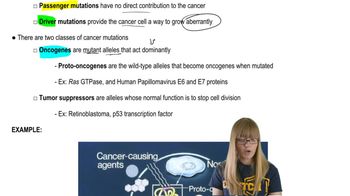Here are the essential concepts you must grasp in order to answer the question correctly.
Gene Mutations
Gene mutations are changes in the DNA sequence of an organism's genome. These alterations can occur due to various factors, including errors during DNA replication, environmental influences, or spontaneous chemical changes. Understanding the nature of these mutations is crucial for studying genetic variation and evolution.
Recommended video:
Randomness of Mutations
The randomness of mutations refers to the idea that mutations occur without any specific direction or purpose, often influenced by chance rather than adaptive needs. This concept is supported by statistical analyses showing that mutations arise at a consistent rate across different genes and organisms, indicating that they are not selectively induced.
Recommended video:
DNA Repair Mechanisms
DNA repair mechanisms are cellular processes that correct damage to the DNA molecule, ensuring genomic stability. These mechanisms, such as nucleotide excision repair and mismatch repair, help maintain the integrity of the genetic material. Understanding these processes is essential for comprehending how cells manage mutations and their potential consequences.
Recommended video:

 Verified step by step guidance
Verified step by step guidance


